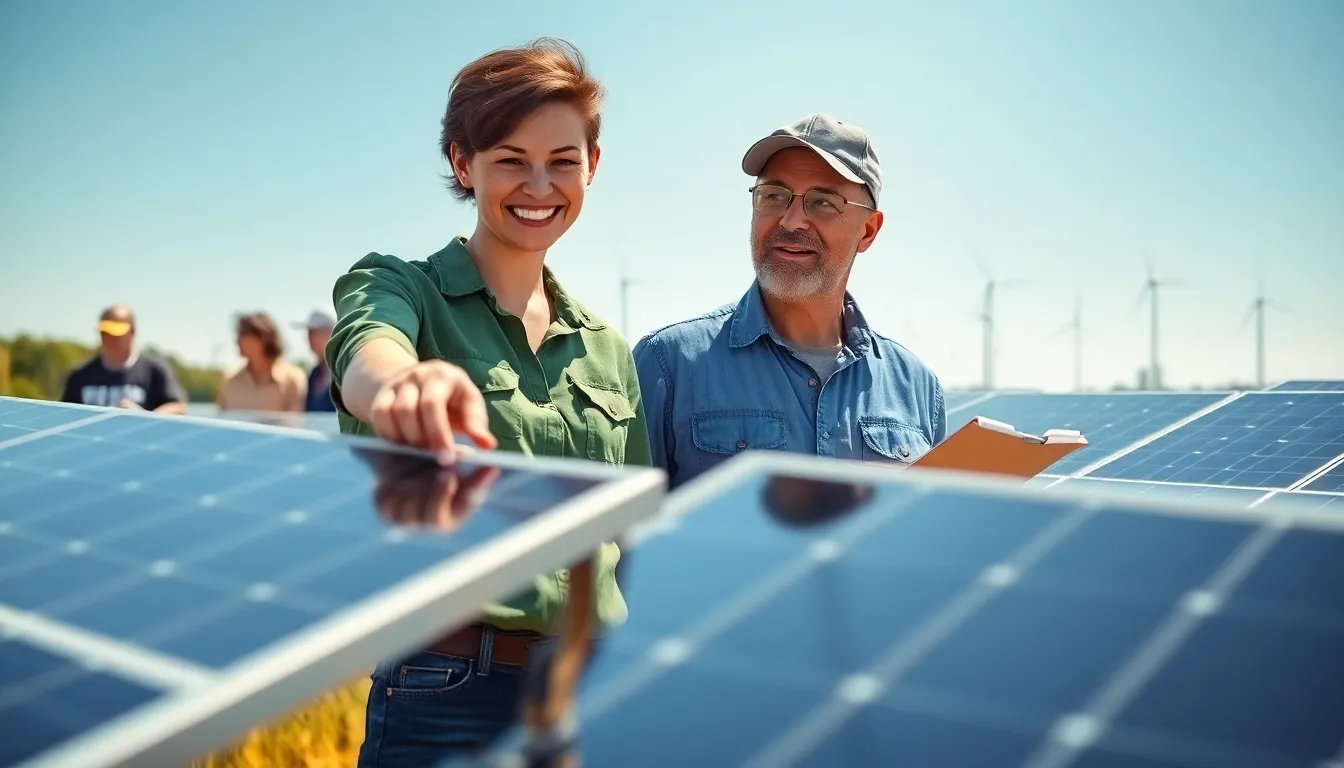As the world grapples with climate change and dwindling fossil fuel reserves, the shift toward renewable energy solutions has never been more critical. These innovative alternatives, harnessing the power of natural resources like sunlight, wind, and water, offer a sustainable path to meet growing energy demands while reducing environmental impact.
The transition to renewable energy isn’t just an environmental necessity; it’s also an economic opportunity. With advancements in technology and decreasing costs, businesses and households alike are turning to solar panels, wind turbines, and other green technologies. This article explores the diverse renewable energy solutions available today and highlights their potential to transform the energy landscape for a cleaner, more sustainable future.
Table of Contents
ToggleOverview of Renewable Energy Solutions
Renewable energy solutions encompass a range of technologies that harness natural resources to produce clean energy. These solutions primarily include solar energy, wind energy, hydroelectric power, geothermal energy, and biomass energy. Each type of renewable energy offers unique benefits and applications.
- Solar Energy: Solar panels convert sunlight into electricity, providing an efficient power source for homes and businesses. The global solar market has seen rapid growth, with installations increasing by over 20% annually since 2010.
- Wind Energy: Wind turbines capture kinetic energy from wind and convert it into electricity. Wind energy accounted for approximately 9% of global electricity production in 2022, illustrating its increasing role in meeting energy needs.
- Hydroelectric Power: Hydropower generates electricity by using flowing water to turn turbines. It represents the largest share of renewable energy production, contributing about 16% of the world’s electricity supply.
- Geothermal Energy: Geothermal systems utilize heat from the earth’s core to produce electricity and provide direct heating. Geothermal energy facilities provide a reliable power source, operating at a capacity factor of 90% or higher in some regions.
- Biomass Energy: Biomass energy comes from organic materials, such as plant and animal waste. It can be converted into biogas or biofuels, providing an innovative solution for waste management and energy production.
Adoption of these renewable energy solutions reflects a broader commitment to sustainability and energy independence. Advancements in technology and decreasing costs enable widespread implementation, positioning renewable energy as a cornerstone of future energy strategies.
Types of Renewable Energy Solutions

Renewable energy solutions encompass various technologies harnessing natural resources to generate sustainable power. These types include solar energy, wind energy, hydropower, biomass energy, and geothermal energy.
Solar Energy
Solar energy captures sunlight using photovoltaic cells or solar thermal systems. Photovoltaic systems convert sunlight directly into electricity, while solar thermal systems utilize sunlight to heat water or air. In 2021, the U.S. installed over 23 gigawatts (GW) of solar capacity, reflecting its widespread adoption for residential and commercial use. Solar energy significantly reduces carbon emissions and lowers electricity bills for users.
Wind Energy
Wind energy derives from the kinetic energy of moving air through turbines. Turbines convert wind motion into electricity, providing a clean and renewable power source. The U.S. has over 130 GW of installed wind capacity, ranking it among the top countries in wind energy production. Wind energy contributes to energy independence and stimulates local economies through job creation in manufacturing and maintenance.
Hydropower
Hydropower generates electricity by harnessing the energy of flowing or falling water, typically through dams. It accounts for approximately 31% of total U.S. renewable electricity generation. Hydropower facilities provide consistent energy and can adjust output based on demand. This technology minimizes carbon emissions and supports flood control and irrigation.
Biomass Energy
Biomass energy comes from organic materials like wood, agricultural crops, and waste. When burned or converted into biofuels, these materials release stored energy. Biomass energy contributes about 5% of U.S. energy consumption, offering a renewable solution that utilizes existing waste products. This process reduces landfill waste and supports sustainable agricultural practices.
Geothermal Energy
Geothermal energy taps into the Earth’s internal heat through geothermal power plants or direct use applications. Geothermal systems provide a reliable energy source, producing approximately 3.7 GW of electricity in the U.S. This energy solution offers consistent power output with minimal environmental impact. Geothermal energy accelerates the transition to a low-carbon economy while enhancing energy security.
Benefits of Renewable Energy Solutions
Renewable energy solutions deliver myriad benefits, addressing both environmental and economic challenges while enhancing energy independence.
Environmental Impact
Renewable energy significantly reduces greenhouse gas emissions, combating climate change effectively. Solar panels and wind turbines produce electricity without pollution, leading to cleaner air and water. The adoption of hydroelectric and geothermal energy also lowers carbon footprints, with hydroelectric plants providing a sustainable energy source while preserving aquatic ecosystems. Using biomass energy contributes to waste reduction and promotes sustainable land use. Investing in renewable resources mitigates environmental degradation, helping preserve natural habitats and biodiversity.
Economic Advantages
Renewable energy solutions generate substantial economic benefits. They create jobs in manufacturing, installation, and maintenance. The solar industry alone supports over 250,000 jobs in the U.S. as of 2022. Lower operational costs associated with renewable technologies lead to decreased electricity bills for consumers and businesses. Furthermore, diverse energy sources stabilize energy prices, reducing reliance on imported fuels. Incentives and subsidies for renewable energy projects attract investments, enhancing local economies.
Energy Independence
Renewable energy solutions strengthen energy independence by diversifying energy sources. Utilizing locally sourced resources like wind, solar, and biomass reduces dependence on imported fossil fuels. This independence enhances national security by insulating economies from geopolitical tensions and fluctuating fuel prices. Building a resilient energy infrastructure through renewables positions communities to respond effectively to energy demands during crises, ensuring a reliable energy supply.
Challenges in Implementing Renewable Energy Solutions
Challenges exist in the transition to renewable energy solutions. These obstacles can hinder widespread adoption and impact the effectiveness of green technologies.
Technological Barriers
Technological barriers present significant hurdles in implementing renewable energy solutions. Efficiency gaps exist in current technologies, affecting overall energy output. For example, solar panels convert approximately 15-20% of sunlight into energy, while new advancements may push this metric higher but face challenges in scalability. Storage technology, such as batteries, struggles to keep up with energy generation variability, leading to energy supply inconsistencies. Furthermore, infrastructure may not support the integration of renewable sources into existing grids, requiring substantial upgrades and investments. Lastly, ongoing research and development play a crucial role in overcoming these technological shortcomings to boost efficiency and reliability.
Policy and Regulatory Issues
Policy and regulatory issues complicate the deployment of renewable energy solutions. Inconsistencies in government incentives, taxes, and subsidies contribute to market uncertainty, discouraging investment. Permitting processes for renewable projects can involve lengthy approval timelines, adding delays to implementation. Additionally, existing policies may favor fossil fuels, leading to competitive disadvantages for renewable technologies. States and local governments may have varying regulations, complicating the landscape for businesses attempting to navigate compliance. Establishing cohesive policies that support renewable energy growth and simplify regulations is essential for fostering a favorable environment.
Embracing renewable energy solutions is vital for a sustainable future. These technologies not only combat climate change but also provide economic growth and energy independence. As advancements continue to lower costs and improve efficiency, the transition to a greener energy landscape becomes more achievable.
Communities and businesses are increasingly recognizing the potential of solar, wind, hydro, geothermal, and biomass energy. By investing in these resources, they contribute to a cleaner environment while reaping the economic benefits.
Overcoming challenges in policy and technology will be crucial in this journey. With collective efforts toward supportive regulations and innovative solutions, a sustainable energy future is within reach.



